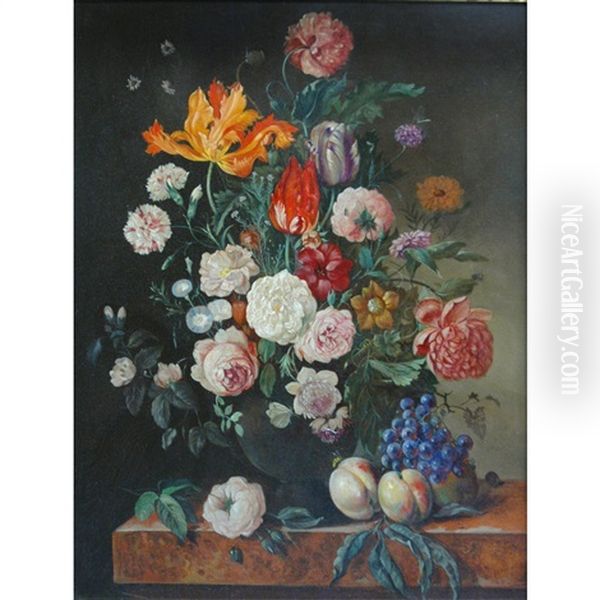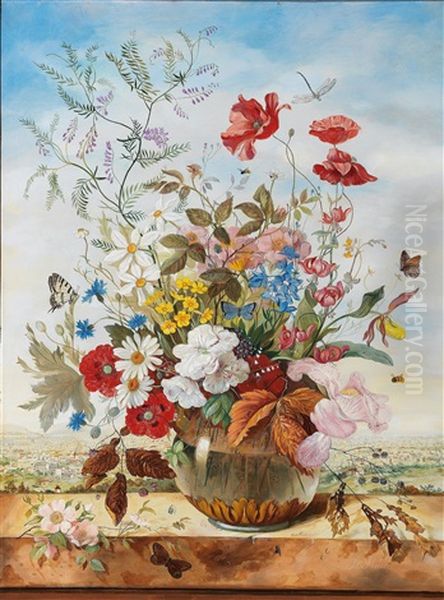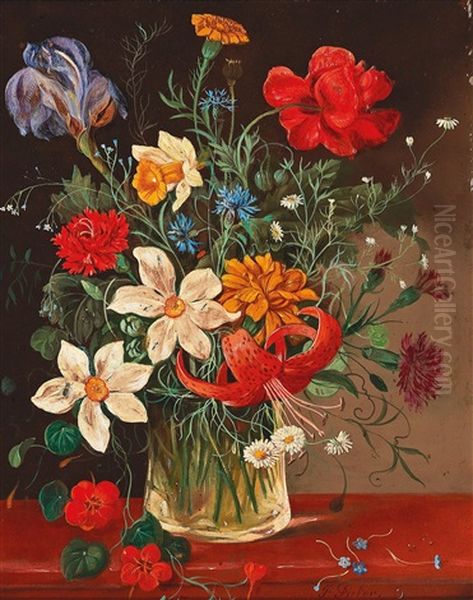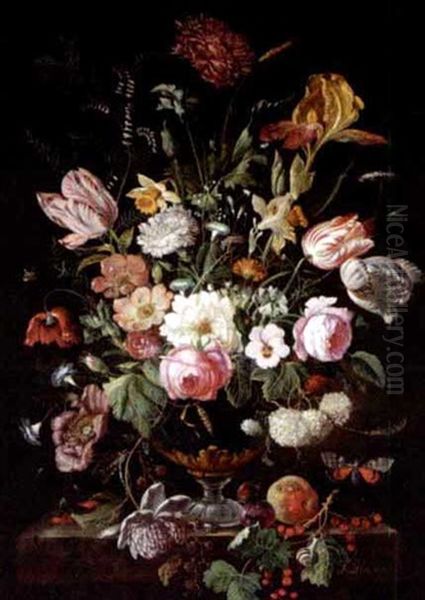Franz Xaver Pieler stands as a figure noted within Austrian art contexts, primarily associated with the city of Vienna. Based on available records, his life spanned from 1876 to 1952. He existed during a vibrant period of cultural and artistic evolution in Europe, witnessing the transition from the late 19th century into the tumultuous modern era of the 20th century. Vienna, his home and place of activity, was a major hub of artistic innovation and tradition during these years.
However, navigating the specific artistic contributions of Franz Xaver Pieler (1876-1952) requires careful attention, as information often intertwines or potentially confuses him with an earlier, highly significant Viennese artist named Franz Xaver Petter (1791-1866). Much of the detailed information regarding Biedermeier still life painting, specific teachers, and artistic styles frequently cited in relation to the name "Franz Xaver P." actually pertains to the elder Petter. This article will present the information as available, acknowledging this potential ambiguity rooted in the similarity of names and shared Viennese context.
Biographical Notes: Pieler and Petter
Franz Xaver Pieler, confirmed to have lived from 1876 to 1952, was an Austrian active in Vienna. Some sources connect him with collections in Klosterneuburg, suggesting a possible role as a collector or an association with the art holdings there. Beyond these basic biographical points and his Viennese location, specific details about Pieler's own artistic training, style, or major works remain less documented in the readily accessible information compared to his namesake.
In contrast, Franz Xaver Petter (born October 27, 1791, died May 11, 1866) is a well-established figure in Austrian art history. He was born and died in Vienna and became one of the most distinguished still life painters of the Viennese Biedermeier period. His life and career unfolded during a time of relative peace and burgeoning middle-class culture in Central Europe, which heavily influenced the themes and aesthetics of the Biedermeier era.
The Biedermeier Context and Franz Xaver Petter

The Biedermeier period, roughly spanning from 1815 (Congress of Vienna) to 1848 (the March Revolutions), was characterized in the arts by a focus on domesticity, sentimentality, realism, and an appreciation for the beauty of the everyday. In painting, this translated into detailed portraits, intimate genre scenes, serene landscapes, and meticulously rendered still lifes. Vienna was a major center for this artistic movement.
Franz Xaver Petter emerged as a leading exponent of Biedermeier still life painting. His work captured the era's sensibilities, focusing on the intricate beauty of nature, particularly flowers and fruit. His paintings were highly sought after, especially among the Austrian nobility, reflecting the refined tastes and appreciation for detailed craftsmanship prevalent at the time. His contribution lies in his ability to elevate still life painting within the Viennese context, continuing and adapting established traditions.
Artistic Education and Influences: The Path of Petter
Franz Xaver Petter received his formal artistic training at the prestigious Academy of Fine Arts Vienna (Akademie der bildenden Künste Wien). This institution was central to artistic education in the Austrian Empire. During his time there, he studied under the guidance of Johann Baptist Drechsler (1756-1811), who was himself a renowned painter of flowers and the head of the flower painting school at the Academy. Drechsler's influence likely shaped Petter's specialization and technical approach.
Petter's work is often seen as continuing the rich tradition of Dutch Golden Age still life painting. Artists from the 17th century Netherlands, such as Jan van Huysum (1682-1749), Rachel Ruysch (1664-1750), Willem van Aelst (1627-1683), and Ambrosius Bosschaert the Elder (1573-1621), had set incredibly high standards for floral and fruit still lifes, characterized by meticulous detail, complex compositions, and often symbolic meanings. Petter adapted this tradition to the Biedermeier aesthetic, emphasizing realism, vibrant color, and often a sense of abundance and natural harmony.
Petter's Artistic Style and Specialization
Franz Xaver Petter specialized primarily in still life compositions. His favoured subjects were elaborate arrangements of flowers, combinations of various fruits, and sometimes compositions that integrated floral elements within a landscape setting. This latter approach, combining landscape vistas with foreground still life elements, offered a unique blend of genres and expanded the traditional boundaries of still life.

His style is characterized by precise draftsmanship, a keen eye for botanical accuracy, and a masterful handling of light and shadow to create volume and texture. The arrangements in his paintings often feature a wide variety of species, depicted at the peak of their bloom or ripeness. The compositions are typically balanced and harmonious, yet full of intricate detail that invites close inspection. He captured the delicate textures of petals, the sheen on fruit skin, and sometimes included elements like insects or dewdrops, enhancing the sense of realism and immediacy, much like his Dutch predecessors.
Representative Works Attributed to Petter
Among the works associated with Franz Xaver Petter is a piece titled Blumenstillleben (Floral Still Life). One such painting is noted as being held in a private collection in Klosterneuburg. While specific details or images of this particular work might require further research into collection archives, the title itself is indicative of his primary subject matter. Such works would typically showcase his skill in arranging and rendering diverse floral species in a visually appealing composition.
Interestingly, another work titled Blumenstillleben, with an estimated creation date around 1950, is also mentioned in related contexts. However, the available information expresses uncertainty about whether this later work is by Franz Xaver Pieler (1876-1952) or perhaps another artist entirely. Given the date (close to Pieler's death), it falls well outside Petter's lifetime, highlighting the need for careful attribution when dealing with similarly named artists and generic titles. Petter's main body of work firmly belongs to the first half of the 19th century.
Contemporaries and Artistic Milieu
Franz Xaver Petter worked during a period rich with artistic talent in Vienna. His teacher, Johann Baptist Drechsler, was a key figure. Other prominent artists of the Austrian Biedermeier era, though perhaps working in different genres, formed the backdrop to Petter's career. These include Ferdinand Georg Waldmüller (1793-1865), known for his portraits, landscapes, and genre scenes; Friedrich von Amerling (1803-1887), a celebrated portrait painter; and Josef Danhauser (1805-1845), known for his genre paintings often carrying moralizing themes. Another flower painter contemporary with Petter and also linked to Drechsler was Sebastian Wegmayr (1776-1857).
While the source materials mention Franz Xaver Messerschmidt (1736-1783), known for his unique "character heads" from an earlier Baroque/Neoclassical period, and Franz Xaver Winterhalter (1805-1873), a German painter famous for his portraits of European royalty slightly overlapping Petter's later career, their direct connection to Petter's immediate circle or style seems limited. Their mention likely arises from the shared "Franz Xaver" name, further emphasizing the potential for confusion across different artists and eras. Petter's primary context remains the Viennese Biedermeier still life school.
Relationships and Legacy

The available information does not detail specific collaborative projects or documented rivalries between Franz Xaver Petter and his contemporaries. However, as a leading still life painter at the Academy and popular among patrons, he would have been a prominent figure within the Vienna art scene. His success implies a level of recognition that inherently placed him within the competitive landscape of artists seeking commissions and acclaim.
Petter's legacy extended beyond his own prolific output. It is noted that his sons also pursued artistic paths, becoming musicians and artists themselves. This suggests a continuation of artistic inclination within the family, contributing to Vienna's cultural fabric. His primary legacy, however, lies in his contribution to Biedermeier art, particularly his mastery of floral still life, which remains admired for its technical brilliance and aesthetic charm, representing a high point of the genre in 19th-century Austria.
Distinguishing Between Pieler and Petter
It is essential to reiterate the distinction suggested by the available data. Franz Xaver Petter (1791-1866) is the artist strongly associated with the Biedermeier still life paintings, the Vienna Academy education under Drechsler, and the influence of Dutch masters. His works are characteristic of the early to mid-19th century Viennese style.
Franz Xaver Pieler (1876-1952), living later, is less clearly defined as an artist in the provided sources. His connection seems more related to Vienna and possibly art collections (Klosterneuburg). While he may have been an artist in his own right, the specific details often attributed under the "Franz Xaver P." umbrella overwhelmingly point towards the earlier Biedermeier master, Petter. Any assessment of Pieler's own artistic career would require distinct sources focusing specifically on his life and work from 1876-1952.
Conclusion: A Tale of Two Artists?
The exploration of Franz Xaver Pieler reveals the complexities that can arise in art historical research, particularly with shared names. While Pieler (1876-1952) is documented as an Austrian figure associated with Vienna, the rich artistic details concerning Biedermeier still life, academic training, and specific works predominantly belong to Franz Xaver Petter (1791-1866).

Petter remains a significant figure in Austrian art history, celebrated for his exquisite still lifes that embody the Biedermeier spirit. His dedication to the genre, influenced by Dutch traditions yet distinctly Viennese, earned him considerable acclaim. His work offers a window into the aesthetic values and cultural milieu of 19th-century Vienna. Understanding his contributions requires separating them from the biographical details of the later Franz Xaver Pieler, ensuring that the legacy of the Biedermeier master is accurately attributed. Further research specifically targeting Franz Xaver Pieler (1876-1952) would be necessary to illuminate his individual path and contributions beyond the shadow of his famous namesake.